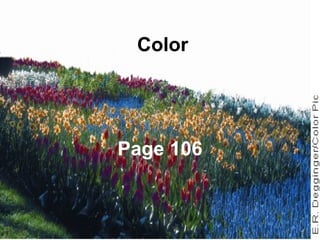Color
- 2. Light on an Object When light strikes an object, the light can be reflected, transmitted, or absorbed Reflected â Light bounces off object Transmitted â Light passes through an object Absorbed â Light does not leave object 107
- 3. Light on an Object Transparent Most light passes right through Translucent Scatters light Can see through but details are blurred Opaque Absorbs all light 108
- 4. Light on an Object 107
- 5. The Color of Objects The color of an opaque object is the color of the light it reflects 108
- 6. The Color of Objects The color of other objects is the color of the light it transmits 109
- 7. Combining Colors Primary Colors Three colors that can combine to make any other color Secondary Color Equal combination of two primary colors 110
- 8. Mixing Light Primary Colors Blue, Green, Red All together they make white Secondary Colors Yellow = Red + Green Magenta = Red + Blue Cyan = Blue + Green Complementary Colors Primary + Secondary Color that make white 110
- 9. Mixing Light Complementary Colors Primary + Secondary Color that make white Green + Magenta Blue + Yellow Red + Cyan 110
- 10. TV Just use combinations of primary colors 110
- 11. Mixing Pigments Pigments absorb some color reflect others When added together you get black Primary pigments Magenta Yellow Cyan 111
- 12. Mixing Pigments Secondary Pigments Green Red Blue Printer Ink Primary Colors + Black ink (four color printing) 111
- 13. Review Reflected, transmitted, absorbed Transparent, translucent, opaque How do objects get color? Primary, Secondary, Complementary Colors Light Colors Mix all you get White Blue, Green, Red Magenta, Cyan, Yellow Pigment Colors Mix all you get Black
- 14. Quiz
- 15. Homework Chose a pigment or light to mix. Describe how the colors mix and what the primary, secondary and complementary colors are.














